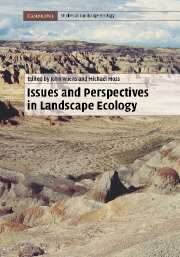Book contents
- Frontmatter
- Contents
- List of contributors
- Preface
- PART I Introductory perspectives
- PART II Theory, experiments, and models in landscape ecology
- PART III Landscape patterns
- PART IV Landscape dynamics on multiple scales
- PART V Applications of landscape ecology
- 18 Landscape ecology as the broker between information supply and management application
- 19 Farmlands for farming and nature
- 20 Landscape ecology and forest management
- 21 Landscape ecology and wildlife management
- 22 Restoration ecology and landscape ecology
- 23 Conservation planning at the landscape scale
- 24 Landscape conservation: a new paradigm for the conservation of biodiversity
- 25 The “why?” and the “so what?” of riverine landscapes
- PART VI Cultural perspectives and landscape planning
- PART VII Retrospect and prospect
- Index
- Plate section
- References
20 - Landscape ecology and forest management
from PART V - Applications of landscape ecology
Published online by Cambridge University Press: 20 November 2009
- Frontmatter
- Contents
- List of contributors
- Preface
- PART I Introductory perspectives
- PART II Theory, experiments, and models in landscape ecology
- PART III Landscape patterns
- PART IV Landscape dynamics on multiple scales
- PART V Applications of landscape ecology
- 18 Landscape ecology as the broker between information supply and management application
- 19 Farmlands for farming and nature
- 20 Landscape ecology and forest management
- 21 Landscape ecology and wildlife management
- 22 Restoration ecology and landscape ecology
- 23 Conservation planning at the landscape scale
- 24 Landscape conservation: a new paradigm for the conservation of biodiversity
- 25 The “why?” and the “so what?” of riverine landscapes
- PART VI Cultural perspectives and landscape planning
- PART VII Retrospect and prospect
- Index
- Plate section
- References
Summary
Almost all activities associated with forest management affect the composition and structure of the landscapes in which they occur. For example, forest harvesting profoundly affects the composition, size, shape, and configuration of patches in the landscape matrix (Table 20.1). Even-age regeneration techniques such as clearcut harvesting have been applied in blocks of uniform size, shape, and distribution, and as strip cuts with alternating leave and cut strips or as progressive cutting of strips, or as patches with variable sizes, shapes, and distributions. In contrast to the coarse-grained pattern (Table 20.1) produced on the landscape by even-age management, uneven-aged regeneration techniques produce small openings in the canopy where individual trees or small groups of trees are periodically harvested.
Roads, another important landscape feature associated with forest management, are essential for a variety of activities including timber and wildlife management, recreation, and the management of fire, insects, and pathogens. Once in place, however, roads greatly alter the ecological character as well as the amount, type, and distribution of human activity on the landscape. At the landscape scale (Table 20.1), roads form a network and road density is closely correlated with the level of forest fragmentation, the amount of forest edge, and, conversely, the amount of forest interior available in the landscape (Forman and Alexander, 1988; Forman, 2000). In addition to maintained or improved roads that are often viewed as external to the forest, every managed forest has a network of unimproved haul roads and skid trails within the forest.
- Type
- Chapter
- Information
- Issues and Perspectives in Landscape Ecology , pp. 201 - 207Publisher: Cambridge University PressPrint publication year: 2005
References
- 3
- Cited by



